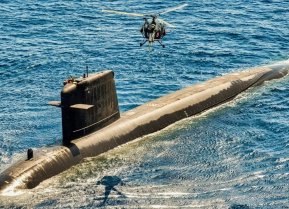Nothing Can Stop the B-52 Stratofortress…Except for Supply Chain Issues
The United States Air Force's B-52 Stratofortress continues to serve as the backbone of the bomber fleet but new upgrades won't be as easy to installs as first thought.
The United States Air Force's B-52 Stratofortress continues to serve as the backbone of the bomber fleet, and over its nearly seven decades in service, it has been described as almost unstoppable. Designed and built by Boeing in the early stages of the Cold War, the B-52 was developed to be a strategic bomber "capable of carrying out the strategic mission without dependence upon advanced and intermediate bases controlled by other countries."
Though 744 were built, with the final aircraft being delivered in October 1962, there are currently 76 in the United States Air Force's inventory. Of those 58 are active with the 2nd Bomb Wing and 5th Bomb Wing, while 18 more are in reserve with the 307th Bomb Wing. Another dozen are in long-term storage at the Davis-Monthan Air Force Base (AFB) "Boneyard."
Its operational capabilities have been adapted over the past seven decades to meet changing defense needs. This included modifications for low-level flight, conventional bombing, and extended-range flights. The current fleet of B-52s can launch ballistic and cruise missiles hundreds of miles from their targets, and there have been efforts to develop hypersonic weapons that can be employed with the bombers.
The Air Force expected the B-52Js with new engines and radars to be ready for service by the end of the decade. The legendary B-52 could reach 100 years in service or longer by the time the platform is finally retired.
As Stars & Stripes reported, a $48.6 billion Pentagon plan calls for the B-52 to receive upgrades to extend its service life until 2060. The bombers would get new Rolls Royce F130 engines, upgraded avionics, radar, and an enlarged and modernized weapons bay. After the transition, the bombers would change their designation to signify a new variant, B-52J.
B-52: It Could be Facing Its Greatest Threat
However, the aircraft may not be quite as unstoppable as believed, and the greatest threat to the Cold War-era long-range bomber may not be a ground-based Surface-to-Air Missile (SAM) system like Russia's S-400 Triumf. The threat the bomber is now facing is one related to the supply chain.
In late November 2023, Inspector General Robert P. Storch announced that the Department of Defense (DoD) Office of Inspector General released the " Audit of B-52 Diminishing Manufacturing Sources and Material Shortages."
The report warned that the U.S. Air Force did not effectively manage diminishing manufacturing sources and material shortages (DMSMS) for the B-52 Stratofortress aircraft, and further emphasized that failure to effectively manage those shortages contributed to spare part shortages.
"Despite its age, the B-52 remains a cornerstone in the Air Force's arsenal," said IG Storch. "While the Air Force's $48.6 billion modernization plan for the aircraft may enhance its capabilities, the supply chain challenges identified in this audit could impact the Air Force's ability to keep the aircraft flying."
The Pentagon OIG's audit further highlighted several concerns regarding the management of B-52 spare parts. Specifically, the B-52 program office did not have an approved management plan to address DMSMS issues or a complete list of B-52 spare parts. To address these issues and others identified in this audit, the DoD OIG made three recommendations to the B-52 system program office, including a recommendation to implement a DMSMS management plan to proactively address spare part shortages.
Addressing the Supply Chain Shortage for B-52
This supply chain shortage is much worse than the lack of toilet paper, frozen pizzas, and backyard pool supplies that Americans faced at the height of the Covid-19 pandemic.
As a result of the shortages, the audit noted the U.S. Air Force relied all too often on cannibalizing parts from existing aircraft, which led to fewer mission-ready aircraft. Waiting for parts has also diminished the number of aircraft that are mission-ready.
To address the issues, the audit suggested that the audit called for the U.S. Air Force to complete an annual Weapon System Support Program coding review to ensure the proper codes for spare parts are in the inventory system. The program would be worked out with the Defense Logistics Agency.
Air Force officials have so far agreed to that point but were only partially responsive to two other recommendations, and their respective status remains open for audit and review. The recommendations included compiling a complete list of spare parts of the B-52 and a signed document creating a system to identify and track manufacturers making components and monitor their ongoing plans to continue or terminate making parts.
Given the issues with the supply chain, the question will be whether the B-52s can really remain flying for decades to come.
Author Experience and Expertise
Peter Suciu is a Michigan-based writer. He has contributed to more than four dozen magazines, newspapers, and websites with over 3,200 published pieces over a twenty-year career in journalism. He regularly writes about military hardware, firearms history, cybersecurity, politics, and international affairs. Peter is also a Contributing Writer for Forbes and Clearance Jobs. You can follow him on Twitter: @PeterSuciu.
Image Credit: Shutterstock.


